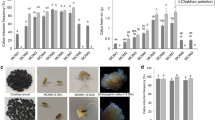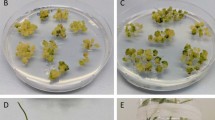Abstract
We report here a high-efficiency transformation protocol for recalcitrant indica rice cultivars IR64 and IR72 with the selectable marker genehph and thegusA reporter gene. Factors that favor high-efficiency transformation were found to be use of 2-month-old mature seed-derived embryogenic calli, maltose as a source of carbon, a higher concentration of 2,4-dichlorophenoxyacetic acid, and both phytagel and agar as gelling agents. The putative transgenic (T0) plants were analyzed for integration of the transgene through polymerase chain reaction and Southern blotting analyses. Various factors thought to be responsible for increased transformation efficiency are discussed.
Similar content being viewed by others
Abbreviations
- 2,4-D:
-
2,4-dichlorophenoxyacetic acid
- BAP:
-
6-benzylaminopurine
- MS:
-
Murashige and Skoog
- NAA:
-
α-naphthaleneacetic acid
- OD:
-
optical density
- PCR:
-
polymerase chain reaction
References
Aldemita PR and Hodges TK (1996)Agrobacterium tumefaciens-mediated transformation of japonica and indica rice varieties. Planta 199: 612–617.
Chilton MD, Currier TC, Farrand SK, Bendich AJ, Gordon MP, and Nester EW (1974)Agrobacterium tumefaciens DNA and P58 bacteriophage DNA not detected in crown gall tumours. Proc Natl Acad Sci USA 71: 3672–3676.
Datta K, Koukolikova-Nicola Z, Baisakh N, Oliva N, and Datta SK (2000)Agrobacterium-mediated engineering for sheath blight resistance of indica rice cultivars from different ecosystems. Theor Appl Genet 100: 832–839.
Datta K, Tu J, Oliva N, Ona I, Velazhahan R, Mew TW, Muthukrishnan S, and Datta SK (2001) Enhanced resistance to sheath blight by constitutive expression of infection-related rice chitinase in transgenic elite indica rice cultivars. Plant Sci 60: 405–414.
Datta K, Velazhahan R, Oliva N, Ona I, Mew T, Kush GS, Muthukrishnan S, and Datta SK (1999) Over-expression of the cloned rice thaumatin-like protein (PR-5) gene in transgenic rice plants enhances environmental friendly resistance toRhizoctonia solani causing sheath blight disease. Theor Appl Genet 98: 1138–1145.
Dellaporta SL, Wood J, and Hicks JB (1983) A plant DNA minipreparation: version II. Plant Mol Biol Rep 1: 19–21.
Ditta G, Stanfield S, Corbin D, and Helinski D (1980) Broad host range DNA cloning system for gram-negative bacteria: construction of a gene bank ofRhizobium meliloti. Proc Natl Acad Sci USA 77: 7347–7351.
Hiei Y, Ohta S, Komari T, and Kumashiro T (1994) Efficient transformation of rice (Oryzasativa L.) mediated byAgrobacterium and sequence analysis of the boundaries of the T-DNA. Plant J 6: 271–282.
Jain RK, Davey MR, Cocking EC, and Wu R (1997) Carbohydrate and osmotic requirements for high-frequency plant regeneration from protoplast-derived colonies of indica and japonica rice varieties. J Exp Botany 48: 751–758.
Khanna HK and Raina SK (1999)Agrobacterium-mediated transformation of indica rice cultivars using binary and superbinary vectors. Aust J Plant Physiol 26: 311–324.
Khanna HK and Raina SK (2002) Elite indica transgenic rice plants expressing modifiedCry1A(c) endotoxin ofBacillus thuringiensis showed enhanced resistance to yellow stem borer (Scirpophaga incertulas). Transgenic Res 11: 411–423.
Murashige T and Skoog FA (1962) A revised medium for rapid growth and bioassays with tobacco tissue cultures. Physiol Plant 15: 473–497.
Park SH, Pinson SRM, and Smith RH (1996) T-DNA integration into genomic DNA of rice followingAgrobacterium inoculation of isolated shoot apices. Plant Mol Biol 32: 1135–1148.
Rashid H, Yokoi S, Toriyama K, and Hinata K (1996) Transgenic plant production mediated byAgrobacterium in indica rice. Plant Cell Rep 15: 727–730.
Roberts-Oehlschlager SL, Dunwell JM, and Faulks R (1990) Changes in sugar content of barley anther during culture on different carbohydrates. Plant Cell Tissue Organ Cult 22: 77–85.
Sambrook J, Fritsch EF, and Maniatis T (1989) Molecular Cloning: A Laboratory Manual, 2d ed. Cold Spring Harbor Laboratory Press, Cold Spring Harbor, New York.
Toriyama K and Hinata K (1985) Cell suspension and protoplast culture in rice. Plant Sci 41: 179–183.
Tu J, Ona I, Zhang Q, Mew TW, Khush GS, and Datta SK (1998) Transgenic rice variety IR72 withXa21 is resistant to bacterial blight. Theor Appl Genet 97: 31–36.
Zhang S, Song WY, Chen L, Ruan D, Taylor N, Ronald PC, Beachy RN, and Fauquet CM (1998) Transgenic elite indica rice varieties, resistant toXanthomonas oryzae pv.oryzae. Mol Breed 4: 551–558.
Author information
Authors and Affiliations
Rights and permissions
About this article
Cite this article
Kumar, K.K., Maruthasalam, S., Loganathan, M. et al. An improvedAgrobacterium-mediated transformation protocol for recalcitrant elite indica rice cultivars. Plant Mol Biol Rep 23, 67–73 (2005). https://doi.org/10.1007/BF02772648
Published:
Issue Date:
DOI: https://doi.org/10.1007/BF02772648




